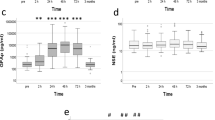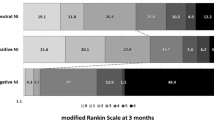Abstract
Circulating brain-derived neurotrophic factor (BDNF) has been highlighted as being a key regulator of rehabilitation-induced recovery after stroke. The aim of this study was to evaluate the association between serum levels of BDNF and functional outcome and mortality events in a 3-month follow-up study in a cohort of patients with an acute ischemic stroke (AIS). From January 2015 to December 2015, consecutive first-ever AIS patients admitted to the Department of Emergency of our hospital were identified. Serum BDNF levels were measured at admission. Functional outcome was evaluated at 3 months using the modified Rankin scale (m-Rankin). We used logistic regression models to assess the relationship between BDNF levels and functional outcome or mortality. In this study, 204 patients were included. Patients with poor outcomes and non-survivors had significantly lower BDNF levels on admission (P < 0.0001 all). Multivariate logistic regression analysis adjusted for common risk factors showed that BDNF levels in the lowest interquartile (≤1st 9.2 ng/ml) was an independent predictor of functional outcome (odds ratios [OR] = 3.75; 95 % confidence interval [CI], 2.43–8.12) and mortality (OR = 4.04; 95 % CI, 2.07–9.14). The area under the receiver operating characteristic curve of BDNF was 0.77 (95 % CI, 0.70–0.84) for functional outcome and 0.79 (95 % CI, 0.71–0.86) for mortality. The findings indicated that low serum levels of BDNF at admission were significantly associated with poor short-term functional outcome and mortality, suggesting that BDNF may serve as a biomarker of poor function outcome after stroke.


Similar content being viewed by others

References
Zhang ZG, Wang C, Wang J et al (2015) Prognostic value of mannose-binding lectin: 90-day outcome in patients with acute ischemic stroke. Mol Neurobiol 51(1):230–239
Bonita R, Mendis S, Truelsen T, Bogousslavsky J, Toole J, Yatsu F (2004) The global stroke initiative. Lancet Neurol 3:391–393
Tu WJ, Dong X, Zhao SJ, Yang DG, Chen H (2013) Prognostic value of plasma neuroendocrine biomarkers in patients with acute ischemic stroke. J Neuroendocrinol 25:771–778
Autry AE, Monteggia LM (2012) Brain-derived neurotrophic factor and neuropsychiatric disorders. Pharmacol Rev 64(2):238–258
Molendijk ML, Bus BAA, Spinhoven P et al (2011) Serum levels of brain-derived neurotrophic factor in major depressive disorder: state–trait issues, clinical features and pharmacological treatment. Mol Psychiatry 16(11):1088–1095
Li B, Lang N, Cheng ZF (2015) Serum levels of brain-derived neurotrophic factor are associated with diabetes risk, complications, and obesity: a cohort study from Chinese patients with type 2 diabetes. Mol Neurobiol. doi:10.1007/s12035-015-9461-2
Takashio S, Sugiyama S, Yamamuro M et al (2015) Significance of low plasma levels of brain-derived neurotrophic factor in patients with heart failure. Am J Cardiol 116(2):243–249
Song JH, Yu JT, Tan L (2015) Brain-derived neurotrophic factor in Alzheimer’s disease: risk, mechanisms, and therapy. Mol Neurobiol 52(3):1477–1493
Choi S, Han KM, Won E et al (2015) Association of brain-derived neurotrophic factor DNA methylation and reduced white matter integrity in the anterior corona radiata in major depression. J Affect Disord 172:74–80
Weinstein G, Beiser AS, Choi SH et al (2014) Serum brain-derived neurotrophic factor and the risk for dementia: the Framingham Heart Study. JAMA neurology 71(1):55–61
Meng WD, Sun SJ, Yang J et al (2016) Elevated serum brain-derived neurotrophic factor (BDNF) but not BDNF gene Val66Met polymorphism is associated with autism spectrum disorders. Mol Neurobiol. doi:10.1007/s12035-016-9721-9
Korley FK, Diaz-Arrastia R, Wu AHB et al (2016) Circulating brain-derived neurotrophic factor has diagnostic and prognostic value in traumatic brain injury. J Neurotrauma 33(2):215–225
Cook DJ, Nguyen C, Chun HN et al (2016) Hydrogel-delivered brain-derived neurotrophic factor promotes tissue repair and recovery after stroke. J Cereb Blood Flow Metab. doi:10.1177/0271678X16649964
Ploughman M, Windle V, MacLellan CL et al (2009) Brain-derived neurotrophic factor contributes to recovery of skilled reaching after focal ischemia in rats. Stroke 40(4):1490–1495
Ploughman M, Granter-Button S, Chernenko G et al (2007) Exercise intensity influences the temporal profile of growth factors involved in neuronal plasticity following focal ischemia. Brain Res 1150:207–216
Clarkson AN, Overman JJ, Zhong S et al (2011) AMPA receptor-induced local brain-derived neurotrophic factor signaling mediates motor recovery after stroke. J Neurosci 31(10):3766–3775
Fritsch B, Reis J, Martinowich K et al (2010) Direct current stimulation promotes BDNF-dependent synaptic plasticity: potential implications for motor learning. Neuron 66(2):198–204
Adams HP Jr, Bendixen BH, Kappelle LJ et al (1993) Classification of subtype of acute ischemic stroke. Definitions for use in a multicenter clinical trial. TOAST. Trial of Org 10172 in Acute Stroke Treatment. Stroke 24:35–41
Bamford J, Sandercock P, Dennis M, Burn J, Warlow C (1991) Classification and natural history of clinically identifiable subtypes of cerebral infarction. Lancet 337:1521–1526
Sims JR, Gharai LR, Schaefer PW, Vangel M, Rosenthal ES (2009) ABC/2 for rapid clinical estimate of infarct, perfusion, and mismatch volumes. Neurology 72:2104–2110
Zeng X, Zhang G, Yang B et al (2016) Neopterin as a predictor of functional outcome and mortality in Chinese patients with acute ischemic stroke. Mol Neurobiol 53(6):3939–3947
Calabrese F, Rossetti AC, Racagni G et al (2014) Brain-derived neurotrophic factor: a bridge between inflammation and neuroplasticity. Front Cell Neurosci 8:430
Berretta A, Tzeng YC, Clarkson AN (2014) Post-stroke recovery: the role of activity-dependent release of brain-derived neurotrophic factor. Expert Rev Neurother 14(11):1335–1344
Stanne TM, Åberg ND, Nilsson S et al (2016) Low circulating acute brain-derived neurotrophic factor levels are associated with poor long-term functional outcome after ischemic stroke. Stroke 47(7):1943–1945
Niimi M, Hashimoto K, Kakuda W et al (2016) Role of brain-derived neurotrophic factor in beneficial effects of repetitive transcranial magnetic stimulation for upper limb hemiparesis after stroke. PLoS One 11(3):e0152241
Fukushima A, Kinugawa S, Homma T et al (2015) Serum brain-derived neurotropic factor level predicts adverse clinical outcomes in patients with heart failure. J Card Fail 21(4):300–306
Kaess BM, Preis SR, Lieb W et al (2015) Circulating brain-derived neurotrophic factor concentrations and the risk of cardiovascular disease in the community. J Am Heart Assoc 4(3):e001544
Li J, Zhao YD, Zeng JW et al (2014) Serum brain-derived neurotrophic factor levels in post-stroke depression. J Affect Disord 168:373–379
Pikula A, Beiser AS, Chen TC et al (2013) Serum brain-derived neurotrophic factor and vascular endothelial growth factor levels are associated with risk of stroke and vascular brain injury Framingham study. Stroke 44(10):2768–2775
Rodier M, Quirié A, Prigent-Tessier A et al (2015) Relevance of post-stroke circulating BDNF levels as a prognostic biomarker of stroke outcome. Impact of rt-PA treatment. PLoS One 10(10):e0140668
Kuczewski N, Porcher C, Gaiarsa J-L (2010) Activity-dependent dendritic secretion of brain-derived neurotrophic factor modulates synaptic plasticity. Eur J Neurosci 32(8):1239–1244
Ferrer I, Krupinski J, Goutan E et al (2001) Brain-derived neurotrophic factor reduces cortical cell death by ischemia after middle cerebral artery occlusion in the rat. Acta Neuropathol 101(3):229–238
Kermani P, Hempstead B (2007) Brain-derived neurotrophic factor: a newly described mediator of angiogenesis. Trends Cardiovasc Med 17(4):140–143
Schabitz W-R, Steigleder T, Cooper-Kuhn CM et al (2007) Intravenous brain-derived neurotrophic factor enhances poststroke sensorimotor recovery and stimulates neurogenesis. Stroke 38(7):2165–2172
Mamounas LA, Altar CA, Blue ME et al (2000) BDNF promotes the regenerative sprouting, but not survival, of injured serotonergic axons in the adult rat brain. J Neurosci 20(2):771–782
Waterhouse EG, Xu B (2009) New insights into the role of brain-derived neurotrophic factor in synaptic plasticity. Mol Cell Neurosci 42(2):81–89
Lu H, Liu X, Zhang N et al (2016) Neuroprotective effects of brain-derived neurotrophic factor and noggin-modified bone mesenchymal stem cells in focal cerebral ischemia in rats. J Stroke Cerebrovasc Dis 25(2):410–418
Qin L, Kim E, Ratan R et al (2011) Genetic variant of BDNF (Val66Met) polymorphism attenuates stroke-induced angiogenic responses by enhancing anti-angiogenic mediator CD36 expression. J Neurosci 31(2):775–783
Fouda AY, Alhusban A, Ishrat T et al (2016) Brain-derived neurotrophic factor knockdown blocks the angiogenic and protective effects of angiotensin modulation after experimental stroke. Mol Neurobiol. doi:10.1007/s12035-015-9675-3
Xuan W, Agrawal T, Huang L et al (2015) Low-level laser therapy for traumatic brain injury in mice increases brain derived neurotrophic factor (BDNF) and synaptogenesis. J Biophotonics 8(6):502–511
Chan A, Yan J, Csurhes P et al (2015) Circulating brain derived neurotrophic factor (BDNF) and frequency of BDNF positive T cells in peripheral blood in human ischemic stroke: effect on outcome. J Neuroimmunol 286:42–47
Ramos-Cejudo J, Gutiérrez-Fernández M, Otero-Ortega L et al (2015) Brain-derived neurotrophic factor administration mediated oligodendrocyte differentiation and myelin formation in subcortical ischemic stroke. Stroke 46(1):221–228
Jiang C, Zuo F, Wang Y et al (2016) Progesterone changes VEGF and BDNF expression and promotes neurogenesis after ischemic stroke. Mol Neurobiol. doi:10.1007/s12035-015-9651-y
El-Tamawy MS, Abd-Allah F, Ahmed SM et al (2014) Aerobic exercises enhance cognitive functions and brain derived neurotrophic factor in ischemic stroke patients. NeuroRehabilitation 34(1):209–213
Di Lazzaro V, Pellegrino G, Di Pino G et al (2015) Val66Met BDNF gene polymorphism influences human motor cortex plasticity in acute stroke. Brain stimulation 8(1):92–96
Kim DY, Quinlan EB, Gramer R et al (2016) BDNF Val66Met polymorphism is related to motor system function after stroke. Phys Ther 96(4):533–539
Acknowledgments
We are grateful to the Department of Emergency; the nurses, physicians, and patients who participated in our study; and the staff of the central laboratory of our hospital.
Author Contributions
Li LH had full access to all of the data in the study and takes responsibility for the integrity of the data and the accuracy of the data analysis.
Study concept and design: Wang J, Gao L, Yang YL, Li YQ, Chang T, Guo SC, and Li LH.
Acquisition of data: Wang J, Gao L, Yang YL, and Li LH.
Analysis and interpretation of data: Wang J, Man MH, Zhang XY, and Guo SC.
Drafting of the manuscript: Wang J, Gao L, Yang YL, Zhang XY, and Li LH.
Critical revision of the manuscript for important intellectual content: Li YQ, Chang T, Man MH, and Guo SC.
Obtained funding: Li LH.
Administrative, technical, or material support: Yang YL, Li YQ, Chang T, and Guo SC.
Study supervision: Li LH.
Author information
Authors and Affiliations
Corresponding author
Ethics declarations
Conflict of Interest
The authors declare that they have no conflict of interest.
Research Involving Human Participants
This study was approved by the Institutional Review Board of the Tangdu Hospital of Fourth Military Medical University.
Informed Consent
Informed written consent was obtained from each patient, family, or legal guardian.
Additional information
Jing Wang and Li Gao contributed equally to this study.
Rights and permissions
About this article
Cite this article
Wang, J., Gao, L., Yang, YL. et al. Low Serum Levels of Brain-Derived Neurotrophic Factor Were Associated with Poor Short-Term Functional Outcome and Mortality in Acute Ischemic Stroke. Mol Neurobiol 54, 7335–7342 (2017). https://doi.org/10.1007/s12035-016-0236-1
Received:
Accepted:
Published:
Issue Date:
DOI: https://doi.org/10.1007/s12035-016-0236-1



